
Electronic english version since 2022 |
The newspaper was founded in November 1957
| |
FLNP turns 65
The event is over, new projects are ahead
On 28 October, the 65th anniversary of the Frank Laboratory of Neutron Physics of JINR was celebrated. The hall of the JINR International Conference Centre could hardly accommodate FLNP staff members and guests from all the laboratories of the Institute. Opening the anniversary seminar, FLNP Director V.N.Shvetsov noted that the date was conditional, chosen close to the birthday date of Ilya Mikhailovich Frank: "We have decided to get together and to see what has been done within 65 years in the field of neutron sources and scientific research with neutrons."
"The laboratory has something to be proud of, I congratulate you and all of us on this anniversary," JINR Director G.V.Trubnikov began his speech. "FLNP is lucky with the people who established it, fortunately, many of the veterans are still among us. The reactor IBR-2 is not only a source of neutrons for experiments, it is also a source of energy, particles of which are in each of you, a source of inspiration for great, glorious deeds. I think, it is fair to say a few words about Valery Nikolaevich Shvetsov. The laboratories have always been lucky with their Directors: large facilities started up headed by V.L.Aksenov, A.V.Belushkin, Valery Nikolayevich has pushed the boundaries of the entire infrastructure, under him the laboratory has flourished in a certain sense, in the last decade unique facilities have been developed at FLNP."
G.V.Trubnikov wished all FLNP employees not to calm down, to develop and to hold scientific schools, to please with good results and wonderful science.
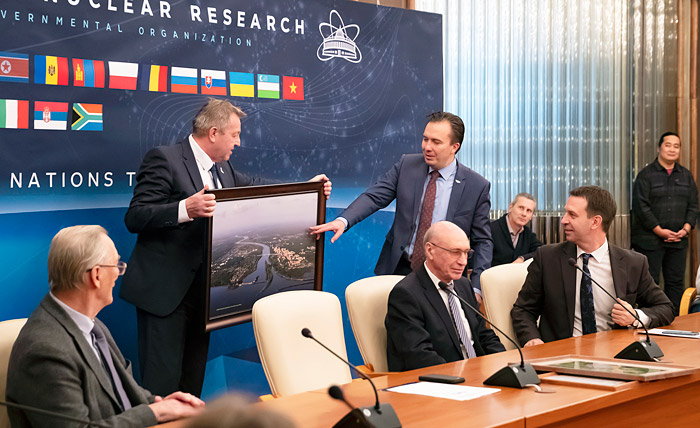
"How can you see a laboratory in the city?" asked Head of Dubna city district S.A.Kulikov, a recent employee of FLNP. "According to two monuments - to D.I.Blokhintsev and to I.M.Frank and also, Ilya Mikhailovich was an honorary citizen of the city. The laboratory has ambitious plans, it has always taken on projects that no one has dared to carry out in the world. I would like to wish the youth that the energy of your senior colleagues will always be at its highest pitch and the results will be visible in the world."
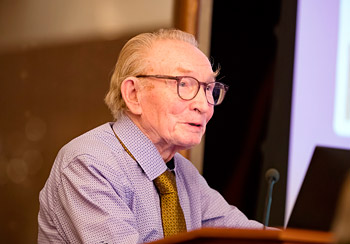 Further, V. N. Shvetsov gave the floor to "the man-history who, together with D.I.Blokhintsev, headed the start-up of the first IBR reactor, as well as has proposed the idea of a new reactor that I hope, will also start up under his supervision" - Evgeny Pavlovich Shabalin. In his report "Pulsed reactors are the uphill road of FLNP", he spoke about the history of the development of pulsed reactors that started in 1945, the history of the development of the first IBR reactor that was launched just 4 years after the idea had come to D.I.Blokhintsev. And later, a booster was added to the reactor, afterwards, they tried to increase the reactor power, most often at the initiative of Fedor Lvovich Shapiro: "Friends, more power!" In 1965, they had to choose how to increase it further: to modify the fuel core or to work on a project for a more powerful reactor? They chose nothing - they just modified IBR into IBR-30 and at the same time started to develop IBR-2, the start-up of which took place in 1977. And IBR-30, as Evgeny Pavlovich noted, could still operate today: the new fuel rods installed in the core after the accident in 1972 had a safety margin of 30 years.
Further, V. N. Shvetsov gave the floor to "the man-history who, together with D.I.Blokhintsev, headed the start-up of the first IBR reactor, as well as has proposed the idea of a new reactor that I hope, will also start up under his supervision" - Evgeny Pavlovich Shabalin. In his report "Pulsed reactors are the uphill road of FLNP", he spoke about the history of the development of pulsed reactors that started in 1945, the history of the development of the first IBR reactor that was launched just 4 years after the idea had come to D.I.Blokhintsev. And later, a booster was added to the reactor, afterwards, they tried to increase the reactor power, most often at the initiative of Fedor Lvovich Shapiro: "Friends, more power!" In 1965, they had to choose how to increase it further: to modify the fuel core or to work on a project for a more powerful reactor? They chose nothing - they just modified IBR into IBR-30 and at the same time started to develop IBR-2, the start-up of which took place in 1977. And IBR-30, as Evgeny Pavlovich noted, could still operate today: the new fuel rods installed in the core after the accident in 1972 had a safety margin of 30 years.
E.P.Shabalin presented the schematic of the IBR-2 reactor, dwelled on the most complex element - the reactivity modulator, spoke about the modernization of the reactor. The newly occurred issue of increasing power after considering possible options was resolved in favor of developing a new one. Work on the Neptune concept has been underway since 2015. It gives hope that the required power threshold of 10 MW will be exceeded. In the conditional genealogical tree of research reactors, IBR holds a special place that gives no branches. "We have been alone for all these 65 years. We have learned from our mistakes, since there have been no other ones." The speaker noted that mistakes were more important than successes and talked about them, as well as how they had been corrected.
"Pulsed reactors are a road uphill, but the mountain is high and the weather is unfavorable, but the clouds will disperse and the charming peak will appear before our eyes…" E.P.Shabalin concluded his speech.
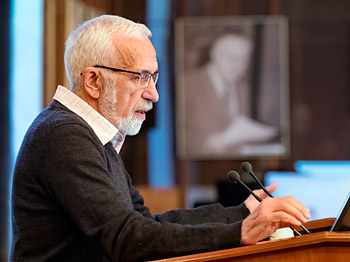 His report "IBR-30 and Fundamental Nuclear Physics. Selected Chapters" W.I.Furman started as follows: "65 years is a period comparable to the average life expectancy of men in Russia. The laboratory has survived this age and, I hope, will develop further. IBR-30 has always been the brightest source in Europe. A strong team gathered around it, headed by Ilya Mikhailovich and Fedor Lvovich. The latter was responsible for developing a scientific programme for this reactor. The basic advantage of pulsed sources is that they allow to study highly excited states of nuclei and beamlines of their decay." Walter Ilyich spoke about selected, breakthrough experiments in this field and not repeated in other papers. As to the speaker, the history of neutron nuclear physics at FLNP is the history of enthusiasts that have proposed new tasks and developed new techniques. It would be interesting to repeat some of the original experiments at the current level.
His report "IBR-30 and Fundamental Nuclear Physics. Selected Chapters" W.I.Furman started as follows: "65 years is a period comparable to the average life expectancy of men in Russia. The laboratory has survived this age and, I hope, will develop further. IBR-30 has always been the brightest source in Europe. A strong team gathered around it, headed by Ilya Mikhailovich and Fedor Lvovich. The latter was responsible for developing a scientific programme for this reactor. The basic advantage of pulsed sources is that they allow to study highly excited states of nuclei and beamlines of their decay." Walter Ilyich spoke about selected, breakthrough experiments in this field and not repeated in other papers. As to the speaker, the history of neutron nuclear physics at FLNP is the history of enthusiasts that have proposed new tasks and developed new techniques. It would be interesting to repeat some of the original experiments at the current level.
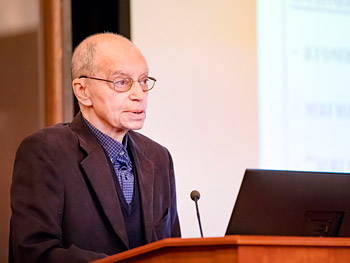 A.M.Balagurov spoke about the development of the second scientific area of FLNP in the report "Neutron scattering in condensed matter research in FLNP (1957-2022)". "F.L.Shapiro worked on the M?ssbauer effect for the first ten years at FLNP and since 1961 the Polish employees E.Janik, B.Buras and their colleagues have started designing the first time-of-flight diffractometer. The Polish group still works, the German and Hungarian groups no longer work, it's a pity if link of times is interrupted."
A.M.Balagurov spoke about the development of the second scientific area of FLNP in the report "Neutron scattering in condensed matter research in FLNP (1957-2022)". "F.L.Shapiro worked on the M?ssbauer effect for the first ten years at FLNP and since 1961 the Polish employees E.Janik, B.Buras and their colleagues have started designing the first time-of-flight diffractometer. The Polish group still works, the German and Hungarian groups no longer work, it's a pity if link of times is interrupted."
Anatoly Mikhailovich divided the development of neutron physics of condensed matter into three stages. The first one was completed in 1980, over the years, the KDSOG, DIN-1, MURN facilities were developed at the IBR and IBR-30 reactors, significant experiments were carried out and Yu.M.Ostanevich became the supervisor of this area. The speaker limited the second period to 2008. He spoke about the work of G.M.Mironova, D.A.Korneev. The so-called applied research developed: texture analysis appeared thanks to colleagues from GDR, D.I.Nikolaev A.N.Nikitin. Even Anatoly Nikolayevich succeeded in effectively organizing the training of students from the Polytechnic and Pedagogical Universities of Tula in Dubna. 58 students came to work in the laboratory and some of them became famous thanks to their activities at the city level. Applied research was also carried out on orders from Rosatom and Tula gunsmiths. During this period, the development of a high-resolution Fourier diffractometer was carried out and fruitful cooperation started with the Faculty of Chemistry of Moscow State University, the construction of DN-12 resulted in the development of a new successful area - diffraction and inelastic scattering at high pressures. These works were awarded the State Prize of the Russian Federation in 2000. In the third period, the very successful construction of new spectrometers and the improvement of the characteristics of current ones are underway. Currently, work is carried out on three new projects. The complex at IBR-2 and its development allow to solve almost any tasks, as A.M.Balagurov emphasized.
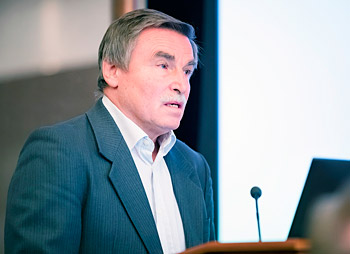 "Sincere thanks to the laboratory, colleagues, not only to those with whom we have developed the biological area, but also to many others," V.I.Gordely (MIPT) began his speech. "I have been working abroad for a long time, I know the level of science there and I can say that the intellectual and professional level of my dear "neutron" is the highest in the world. In his report "Biology in FLNP: from model to biological systems (what I remember)", he started his reminiscences from 1978: "I was lucky that I got into the group of A.M.Balagurov. It was a wonderful team, in which I alone wanted to study biology, having received a specialty in solid state physics. I communicated with I.M.Frank in the last years of his life. He greatly respected his teacher S.I.Vavilov, whose brother was a famous geneticist. Ilya Mikhailovich's brother Gleb Mikhailovich was also a biologist and Head of the Pushchino Biological Centre. Our director invited Gleb Mikhailovich to FLNP to tell physicists about the beauty of biology. There has always been support for this area from the FLNP Directorate and the significance of biological research only increases every year. It is very easy to make JINR a powerful centre for biological research if funds are available." V.I.Gordely spoke about the key areas in the world biology, where people from FLNP, in particular, V.Cherezov, made a decisive contribution, as well as about some current research. "The role of FLNP in modern biology is already colossal. Dubna is a place with great prospects."
"Sincere thanks to the laboratory, colleagues, not only to those with whom we have developed the biological area, but also to many others," V.I.Gordely (MIPT) began his speech. "I have been working abroad for a long time, I know the level of science there and I can say that the intellectual and professional level of my dear "neutron" is the highest in the world. In his report "Biology in FLNP: from model to biological systems (what I remember)", he started his reminiscences from 1978: "I was lucky that I got into the group of A.M.Balagurov. It was a wonderful team, in which I alone wanted to study biology, having received a specialty in solid state physics. I communicated with I.M.Frank in the last years of his life. He greatly respected his teacher S.I.Vavilov, whose brother was a famous geneticist. Ilya Mikhailovich's brother Gleb Mikhailovich was also a biologist and Head of the Pushchino Biological Centre. Our director invited Gleb Mikhailovich to FLNP to tell physicists about the beauty of biology. There has always been support for this area from the FLNP Directorate and the significance of biological research only increases every year. It is very easy to make JINR a powerful centre for biological research if funds are available." V.I.Gordely spoke about the key areas in the world biology, where people from FLNP, in particular, V.Cherezov, made a decisive contribution, as well as about some current research. "The role of FLNP in modern biology is already colossal. Dubna is a place with great prospects."
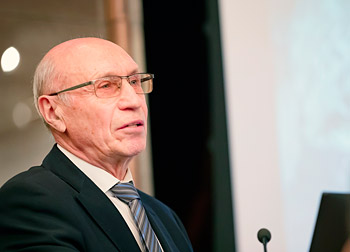 "To complete the picture of the development of FLNP, all that's left to say is a few words about the role of Academician N.N.Bogolyubov in the life of the laboratory as an outstanding scientist and Director of the Institute," V.L.Aksenov took the floor. He showed the influence of N.N.Bogolyubov on the development of condensed matter physics using the example of research of superfluidity and superconductivity referring to it that was carried out at IBR-2 by BLTP employees. Nikolay Nikolayevich was very interested in the high-temperature superconductivity discovered in 1986. The development of the technique of Fourier diffractometry became possible due to his interest in this topic. After him, the attitude towards research on long-pulse sources changed; the European ESS neutron source under construction today has a long pulse. And the work of N.N.Bogolyubov on nonequilibrium stochastic mechanics will still play a role in biological research.
"To complete the picture of the development of FLNP, all that's left to say is a few words about the role of Academician N.N.Bogolyubov in the life of the laboratory as an outstanding scientist and Director of the Institute," V.L.Aksenov took the floor. He showed the influence of N.N.Bogolyubov on the development of condensed matter physics using the example of research of superfluidity and superconductivity referring to it that was carried out at IBR-2 by BLTP employees. Nikolay Nikolayevich was very interested in the high-temperature superconductivity discovered in 1986. The development of the technique of Fourier diffractometry became possible due to his interest in this topic. After him, the attitude towards research on long-pulse sources changed; the European ESS neutron source under construction today has a long pulse. And the work of N.N.Bogolyubov on nonequilibrium stochastic mechanics will still play a role in biological research.
"There is an opinion," V.L.Aksenov continued his story, "that it was Nikolay Nikolayevich who did not allow the reactor to start up (after the physical start-up in 1977, it took place only in 1984). The accident of 1972 left its mark on the attitude of N.N.Bogolyubov to IBR-30. He was assured that nothing serious had happened, but he, of course, guessed. One should not think that he, a mathematician and physicist, was afraid of technology, the reactor. His teacher N.M.Krylov was educated as an engineer and Nikolay that had studied with him from the age of 13, adopted respect for engineering. All their joint work before the Great Patriotic War was aimed at addressing issues in engineering. And everything concerning the work of IBR-2, Nikolay Nikolayevich supported. We have found great people, this is our happiness."
Representatives of VBLHEP, MLIT and LRB, congratulating the veterans of the laboratory and their young colleagues, wished them to look ahead with confidence and implement all projects. And V.V.Korenkov recalled that almost 60 years ago the first beamline, one and a half kilometers long, was laid that transmitted information from the analyzer at FLNP to the first-generation computer "Kyiv". Some FLNP specialists participated in the development of software together with N.N.Govorun and V.P.Shirikov, in the development of local networks. "Today, together with you, we calculate the Neptune project on the Govorun supercomputer, together with M.V.Frontasyeva, we design an atlas of heavy metal pollution in different territories. I see great potential for the development of our cooperation," Director of MLIT said. The words of gratitude for 26 years of fruitful cooperation with research centres and universities in Romania were heartily expressed by Maria Balasoiu. Denesh Nagy (Wigner Research Centre for Physics, Hungary, online) congratulated his colleagues on a wonderful event. "Thank you for the interesting reports, I returned to the times of Yu.M.Ostanevich and F.L.Shapiro. I remember my first visit to Dubna in 1969 for an experiment, my impressions of the interesting infrastructure of FLNP." M.V.Frontasyeva presented a brief overview of the activities of the Sector of Neutron activation analysis and applied research.
The paintings donated to FLNP can make a small gallery and the laboratory itself made memorable gifts to its employees, printing their beautiful portraits and group photographs of the departments.
The event is over, new projects are ahead.
Olga TARANTINA,
photo by Elena Puzynina